

A.I. Is Not What You Think. This article is part of the On Tech newsletter.
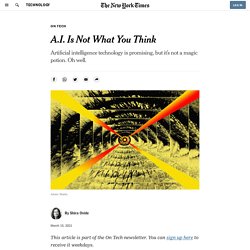
You can sign up here to receive it weekdays. When you hear about artificial intelligence, stop imagining computers that can do everything we can do but better. My colleague Cade Metz, who has a new book about A.I., wants us to understand that the technology is promising but has its downsides: It’s currently less capable than people, and it is being coded with human bias. I spoke with Cade about what artificial intelligence is (and isn’t), areas where he’s hopeful and fearful of the consequences and areas where A.I. falls short of optimists’ hopes. This new tool can tell you if your online photos are helping train facial recognition systems. Training a facial-recognition system to identify people requires a slew of photos of faces — photos that are often gathered from the internet.

It's usually impossible to figure out if images you've uploaded are among them. Exposing.ai, unveiled in January, lets you know whether photos you've posted to image-sharing site Flickr have been used to advance this controversial application of artificial intelligence by allowing you to search more than 3.6 million photos in six facial-recognition image datasets. It's a small number in comparison to the millions of photos spread across countless facial datasets, but plenty of people will still be surprised to find their photos — and faces — included. "It's easiest to understand when it becomes more personal," said Adam Harvey, an artist and researcher, who created the site with fellow artist and programmer Jules LaPlace, and in collaboration with the non-profit Surveillance Technology Oversight Project (STOP).
More datasets coming soon. How one employee's exit shook Google and the AI industry. "Hi Emily, I'm wondering if you've written something regarding ethical considerations of large language models or something you could recommend from others?
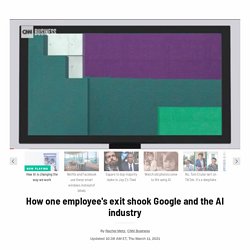
" she asked, referring to a buzzy kind of artificial intelligence software trained on text from an enormous number of webpages. "Sorry, I haven't! " Bender quickly replied to Gebru, according to messages viewed by CNN Business. AI software market to hit $78B by 2025, here are the top applications for the technology. The market for AI software is exploding, with IBM and Google leading global suppliers, according to QY Research.

In 2017, the global software system market size for artificial intelligence (AI) was $2.65 billion. By the end of 2025, however, a new report from QY Research found that it is expected to skyrocket to $78 billion. The market concentration of AI software systems is high, and is expected to stay that way, according to the report. AI used to 'predict the next coronavirus' Computer says go: Taking orders from an AI boss. Alzheimer’s Prediction May Be Found in Writing Tests. Is it possible to predict who will develop Alzheimer’s disease simply by looking at writing patterns years before there are symptoms?
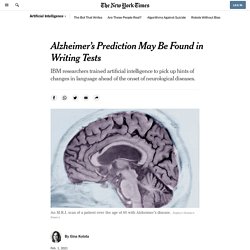
According to a new study by IBM researchers, the answer is yes. Timnit Gebru: Google staff rally behind fired AI researcher. CNTK, el nuevo paquete de herramientas de aprendizaje profundo de código abierto de Microsoft en GitHub - El blog de Windows para América Latina. Microsoft ha comenzado a fabricar las herramientas que sus propios investigadores usan para acelerar los avances en inteligencia artificial que estén disponibles para un amplio grupo de desarrolladores, al lanzar su Paquete de Herramientas de Red Computacional en GitHub.
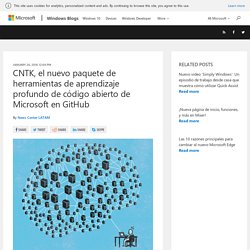
Los investigadores desarrollaron este paquete de herramienta de código abierto, apodado CNTK, por necesidad. Xuedong Huang, jefe científico de habla en Microsoft, dijo que él y su equipo estaban ansiosos por realizar mejoras más rápidas en las formas en las que las computadoras entienden el habla, y cómo las herramientas con las que tenían que trabajar los retrasaban. Así que un grupo de voluntarios se prepararon para resolver este problema por sí solos, con ayuda de una solución casera que resaltó el rendimiento sobre todo lo demás.
El esfuerzo rindió frutos. “El paquete de herramientas CNTK es mucho más eficiente que cualquier otra que hemos visto”, Huang dijo. Xuedong Huang (fotografía por Scott Eklund/Red Box Pictures. The Unreasonable Effectiveness of Recurrent Neural Networks. There’s something magical about Recurrent Neural Networks (RNNs).
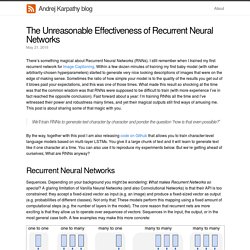
I still remember when I trained my first recurrent network for Image Captioning. Within a few dozen minutes of training my first baby model (with rather arbitrarily-chosen hyperparameters) started to generate very nice looking descriptions of images that were on the edge of making sense. Sometimes the ratio of how simple your model is to the quality of the results you get out of it blows past your expectations, and this was one of those times.
Los intereses comerciales marcan el futuro de la inteligencia artificial. El futuro de la inteligencia artificial genera muchos debates porque será decisiva en campos tan serios como la medicina, las guerras, el trabajo o incluso las relaciones humanas.
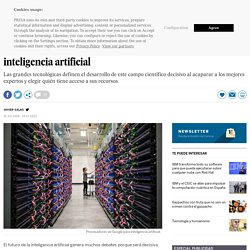
Sin embargo, esos debates a menudo ignoran un asunto que sobrevuela a todos los demás: el desarrollo de las máquinas pensantes ha sido conquistado por empresas tecnológicas que están definiendo cómo será ese futuro. Develop Your First Neural Network in Python With Keras Step-By-Step. Last Updated on September 15, 2020 Keras is a powerful and easy-to-use free open source Python library for developing and evaluating deep learning models.
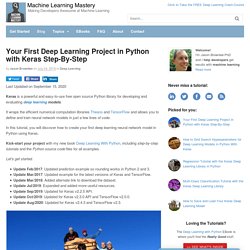
It wraps the efficient numerical computation libraries Theano and TensorFlow and allows you to define and train neural network models in just a few lines of code. Classification with Feed-Forward Neural Networks — PyBrain v0.3 documentation. This tutorial walks you through the process of setting up a dataset for classification, and train a network on it while visualizing the results online.
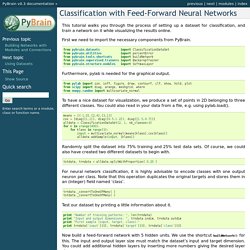
First we need to import the necessary components from PyBrain. from pybrain.datasets import ClassificationDataSetfrom pybrain.utilities import percentErrorfrom pybrain.tools.shortcuts import buildNetworkfrom pybrain.supervised.trainers import BackpropTrainerfrom pybrain.structure.modules import SoftmaxLayer Furthermore, pylab is needed for the graphical output. from pylab import ion, ioff, figure, draw, contourf, clf, show, hold, plotfrom scipy import diag, arange, meshgrid, wherefrom numpy.random import multivariate_normal. The Difference Between AI, Machine Learning, and Deep Learning? This is the first of a multi-part series explaining the fundamentals of deep learning by long-time tech journalist Michael Copeland.